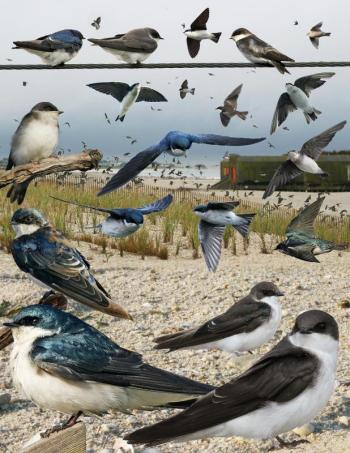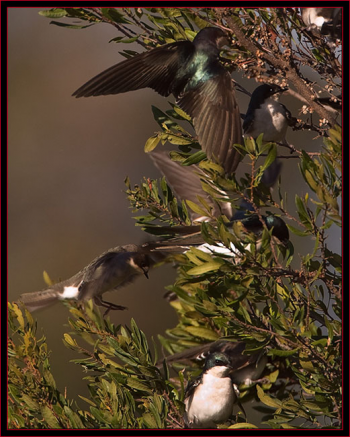Tree Swallows Wintering in Maine?
Tree swallows are a sign of spring for many of us here in Maine. We eagerly await their return on the first extended run of days with strong, warm southerly winds. Sometimes that can bring birds here as early as March. In Upstate New York in Ithaca, we once were shocked to see some tree swallows arrive there on a warm snap in late February! These early arriving birds, not surprisingly, must deal with the inevitable return to cold, more winter-like, conditions. We have written about how important open waterways that have some insect life can be for those birds under those conditions—they are “lifeboats” of sorts.
But of all the species in the swallow family, the tree swallow is the one most likely to be able to deal with such difficulties. Tree swallows winter the farthest north of any of the swallows. While the largest numbers occur in the region from North Carolina south to Florida and along the Gulf Coast into Mexico, smaller numbers have been known to winter occasionally as far north as coastal New York, Connecticut, and Massachusetts.
Most readers will be very aware that tree swallows, like all members of the swallow family, are generally considered strict insect eaters. But tree swallows have broadened their diets to include, in winter at least, berries. In the northernmost part of the range they are known to eat bayberries, great quantities of them. Bayberries are not anything that any of us would normally consider eating (we might be hard-pressed to even call them “berries.” They are small, gray, hard, and covered in wax. In fact, people used to make candles from that wax. Somehow, tree swallows are able to digest that waxy coating, along with the rest of the berry, and get considerable nutrition from the meal.
While the breeding biology of tree swallows has now been exceptionally well studied, even tree swallow experts concede that almost nothing is known about their biology during the winter. The world’s top tree swallow biologists put it this way in the authoritative “Birds of North America” species account: “The biology of non-breeding Tree Swallows remains a black box.”
The wintering biology of tree swallows is on our minds because for the first time in recorded Maine ornithological history, a small number of tree swallows persisted in the state into January. There were no records beyond November in Maine until about 20 years ago. This year, though, was exceptional with a number of small flocks found in December along the coast south of Portland. There were even two January records in Nova Scotia! With the mild conditions, these birds were probably finding some insects, but we’ve also noticed a heavy crop of bayberries in some areas of the coast. Presumably these birds may be using them as a food source.
Given that the species does winter farther north than other swallows, it’s not so surprising that they are the first swallows to return in the spring and that some individuals are wintering close enough that they can push north on the first southerly winds of the season. As adaptable and resilient as tree swallows seem to be, they have shown persistent declines as have virtually all insect-eating birds, as we mentioned in a recent column.
We will be interested to hear if any tree swallows are sighted in Maine after the recent snows and colder weather. It is thought that these birds wintering on the northern edge of what is survivable can make quick movements a bit farther south when conditions get really bad, although that’s also not something that has been well-studied in tree swallows.
With some of the new technology available for studying bird movements and bird biology, maybe in a few years the wintering biology of tree swallows will move from being a “black box” to an “open book?”
Jeffrey V. Wells, Ph.D., is a Fellow of the Cornell Lab of Ornithology. Dr. Wells is one of the nation's leading bird experts and conservation biologists and author of “Birder’s Conservation Handbook”. His grandfather, the late John Chase, was a columnist for the Boothbay Register for many years. Allison Childs Wells, formerly of the Cornell Lab of Ornithology, is a senior director at the Natural Resources Council of Maine, a nonprofit membership organization working statewide to protect the nature of Maine. Both are widely published natural history writers and are the authors of the book, “Maine’s Favorite Birds” and “Birds of Aruba, Bonaire, and Curaçao: A Site and Field Guide” from Cornell Press.
































